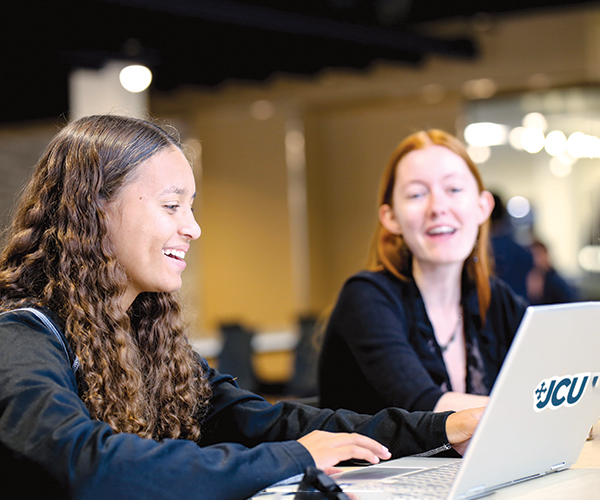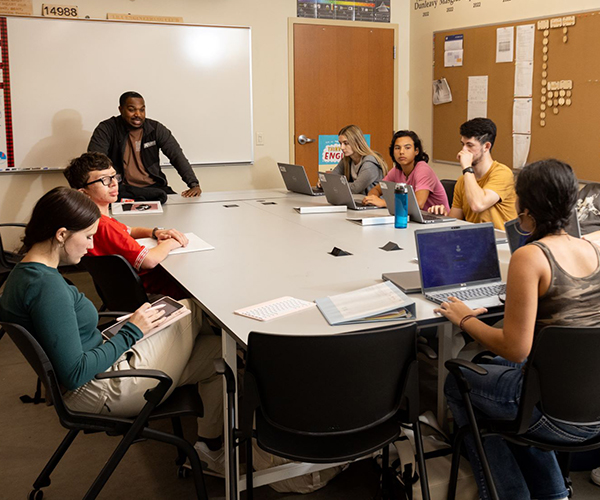Campus Revisted
by Jennifer Keirn | Feb. 26, 2009 | 5:00 AM
Want to sit in on a few classes? Meet with a coach, professor or financial aid officer? Stay overnight in a dorm and try breakfast in a dining hall? Or just kick around campus? All fair game, says Kimberly Shepherd, Ursuline’s director of admissions.
“The hallmark of an Ursuline education and experience is how warm, how personal it is. But if you’re bringing 100 people to campus [for a tour], are you really getting that feeling?” asks Shepherd, who’s seen visits more than double since implementing the new strategy in October. “That works for a school with that big-school, rah-rah spirit, but that model just isn’t very Ursuline.”
Ursuline’s move away from the long-standing college visit tradition is just one example of how colleges and universities — as well as some private high schools — are pulling out new tricks to attract the marketing-skeptical Millennial Generation and their time-stretched parents.
“Colleges can no longer pontificate in monologue about their rankings, stats, et cetera,” says Jeff Kallay, an Atlanta-based college recruiting consultant who worked with Ursuline on its new approach. “They must facilitate a dialogue between prospective families ... engaging families actively versus passively and helping a student decide if the place is or is not a good fit.”
Glossy viewbooks, college fairs and campus tours aren’t marked for extinction quite yet, but they are being joined by one-to-one communication, student blogs and texting campaigns, new uses of social media and the kind of targeted marketing that technology is only beginning to make possible.
Some researchers call the Millennial Generation pampered or spoiled. Others call them savvy and discriminating. But most agree that this generation is accustomed to personal attention from parents and teachers, and they expect no less from a college that seeks their attendance.
“Students want that personal interaction. They want to know the name of their admission counselor and be able to call them,” says Jonathan Wehner, associate director of marketing for undergraduate admission at Case Western Reserve University. “They want to be marketed to, but it’s all about authenticity:Why should I be involved in your institution?”
Alyssa Ogrodowczyk is one of those who found Ursuline’s personal approach to recruitment appealing when she visited last fall. She attends a midsize high school in Erie, Pa., and likes Ursuline’s intimate setting and small class sizes.
“I had control over what I saw,” says Ogrodowczyk, who intends to be a sports management major. (At press time, she had been accepted at Ursuline but has yet to make her final decision on a college.) “The other campus visits were more standardized, with not as much time to talk. It was like, we had to leave at this time to go on our tour.”
A high school softball standout, Ogrodowczyk had lunch with Ursuline’s softball coach and two players, got a peek inside the dorms and classrooms of her choosing and scheduled meetings with financial aid and admissions. She’s also received personal phone calls from students at other prospective institutions offering to answer any questions she may have.
“[These schools] aren’t just like, ‘come to our school,’ ” she says. “They’re more jumping out at me to try to get me to come.”
At a school like Cleveland State University, a largely local student pool allows for highly personalized recruitment tactics. Instead of simply mailing out admission letters, CSU dispatches its Street Team —an energetic band of current students who travel in a CSU-branded Jeep — to deliver admission packets to the homes of selected applicants. The Street Team also makes appearances at Northeast Ohio events, building connections in ways high school students can relate to.
“We had 600 high school students on campus for a career fair, so we created a Rock Band competition to see which high school had the best band,” says Mark Nazario, CSU’s director of admissions. “At first, [administrators] all said, ‘Rock what?’ but then they said, ‘Wow.’ For four hours we were having a blast, with kids looking at materials and signing our cards.”
The personal touch has always won out over mass marketing at the area’s private schools such as Hawken School — whose target audience is more parents than kids — where Head of School Scott Looney says they’re amping up the one-to-one approach by encouraging current and alumni families to host intimate coffees in their homes for friends and neighbors to learn more about the school.
“If you’re selling personal attention in an impersonal way, that doesn’t work,” says Looney. “[This one-to-one approach] is unbelievably time-consuming, but the matches tend to be very good.”
“I am more than a test score” is the catchphrase that invites users to Zinch.com,
the Web site that’s quickly becoming the Facebook of college recruiting. Students create profiles that showcase their interests, talents and career aspirations, give “shout outs” to colleges that interest them, and participate in “talent shows” to post their writing, music, artwork or photography.
Twenty Ohio colleges and universities have signed on to Zinch — including such local institutions as Baldwin-Wallace College, Ursuline and John Carroll University — presenting nearly endless possibilities for targeted recruiting.
At Ursuline, Shepherd wanted to increase awareness for her public relations and marketing communications programs. So she sent an e-mail to 5,788 female prospective PR and communications majors within the Zinch system, offering a free semester’s books to the winner of an essay contest if she ended up enrolling. The response? More than 1,300 essays within the first seven weeks.
But aside from its potential for targeted marketing, Zinch has tapped into students’ need to be seen as individuals, as “more than a test score.”
“There is a lot of anxiety about the test part of it,” says Susan Dileno, vice president of enrollment management at Baldwin-Wallace, referring to most colleges’ dependence on ACT and SAT scores for admissions. To appeal to applicants’ need to be seen as a person, not just a collection of scores, Baldwin-Wallace recently made test scores optional in the admissions process. “It did send a strong message, that we take the time to read everything you send to us,” says Dileno.
Julia Schonberg was drawn to Baldwin-Wallace for its test-optional policy. The senior at Orange High School is applying to eight competitive musical theater programs, including B-W’s Conservatory of Music, and worries that her test scores don’t accurately reflect her potential.
“I have a decent GPA, but I’m not good at taking tests,” says Schonberg. “I don’t think that four hours of your time [taking a test] can take a picture of you as a person as opposed to four years of school.”
Baldwin-Wallace was the only college she applied to that was testing-optional, and Schonberg says it did give the school a leg up on her priority list.
“It shows that B-W gets what I’m thinking, and they don’t think the scores totally reflect you anyway,” she says.
:: Blogging, texting and Twitter
When it comes to an admissions department’s tech savvy, posers need not apply. “Eighteen-year-olds can smell a rat from a mile away,” says Case’s Wehner. “If you’re not in their world, it’s going to turn them off.”
That’s why technology is such a central part of the school’s recruitment strategy, with an undergraduate blog and Case YouTube channel featuring student-produced content, a Case Twitter feed and a Web site designed to be viewed on iPhones and other mobile devices.
“We’re experimenting with these mediums because we know they’re popular with this age group,” says Wehner. “We still pound the pavement, travel and do traditional recruiting, but we also use technology to be a lot smarter about that.”
Namely, Wehner uses technology to build awareness in geographic areas where traditional recruiting could never reach. “It only takes one thing to spark an interest. It’s getting a student to say, ‘Here’s something interesting.’ And you never know what that’s going to be,” he says.
Wehner knows that prospective students are using their iPhones to check sports scores or see what their friends are doing on Twitter. “I want them to be checking out what’s going on at Case,” he says. “I want them to be excited about Case in the same way.”
Many local institutions report that they’re regularly texting and e-mailing prospective students to keep in touch. Independent private school Lake Ridge Academy in North Ridgeville enlists seventh-grade technology students to create animated e-cards to thank prospective students for visiting. Nationally, schools such as Stanford University and Princeton University have even created virtual campuses onSecond Life, where users can explore their resources.
“The control is now with the students,” says Dileno. “They don’t have to fill out our cards at a fair to get information. They have access to it 24/7 online. They remain stealth until they want you to know who they are.”
Many colleges have been slow to come to this realization, says recruitment consultant Kallay. “Most colleges are run by older boomer [generation] white guys who were raised in the golden age of advertising,” he says. “They think they have to have control, but they don’t understand that they are no longer in control.”
The future of college recruiting, says Kallay, will be a shift from mass recruitment techniques in favor of finding better fits with fewer and more targeted students with a message that is more authentic to their identity.
“They will be more honest about who they are and what type of students should come there,” he predicts. “Millennials and their emerging Gen-X parents are averse to traditional marketing. They are quick to spot a phony. They demand authenticity.”
JEFF KALLAY HAS TAKEN MORE THAN 400 COLLEGE TOURS in his job as a college recruitment consultant and self-proclaimed “experience evangelist” and has strong words for the parents evaluating colleges with their kids: “[Parents] get caught up in rankings and brand cache. College is an intimate product choice. You need to pick a place your child is going to graduate from, not a place you just want a bumper sticker or T-shirt from,” Kallay says.
Follow Kallay’s advice to get the most out of your college visits this spring:
››Don’t play “Stump the Tour Guide.” Chuck those tour guide FAQ lists, and instead ask about what they know best. “They’re students. Ask about student life,” says Kallay. “Don’t ask them all the stupid statistical questions that you can find on any Web site.”
››Stray from the admissions office. Take time to get some other opinions. “Go into the student center and just ask some questions. You’d be shocked how open current students are,” Kallay says. “Go to the office of the academic department you’re applying to and ask questions. In a lot of schools, admission is very scripted, and you’ve got to get past that.”
››Pace yourself. Don’t try to squeeze too many tours into one day. “You’re not doing your kids or the school any good,” he says. Take careful notes about what you liked and didn’t like at each school.
››Acknowledge the intangibles. “When I ask college students, ‘Why did you choose this school?,’ 90 percent of the time the answer is ‘I visited, and it felt right,’ ” Kallay reports. A 2004 StudentPoll of incoming college freshmen found that nearly 60 percent said friendly people/atmosphere or appearance of campus were the most positive influences on their perception of a school. If you’re so focused on tangibles like graduate school admission rates and national rankings, you may miss the “feel” your kids are looking for. “There needs to be an honest conversation between parent and child about what kind of environment that child is going to thrive in,” says Kallay
Trending
-
1
-
2
-
3
-
4
-
5










